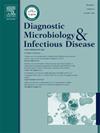Decoding omicron: Genetic insight into its transmission dynamics, severity spectrum and ever-evolving strategies of immune escape in comparison with other SARS-CoV-2 variants
IF 2.1
4区 医学
Q3 INFECTIOUS DISEASES
Diagnostic microbiology and infectious disease
Pub Date : 2025-01-23
DOI:10.1016/j.diagmicrobio.2025.116705
引用次数: 0
Abstract
Background
The coronavirus disease 2019 (COVID-19) pandemic, driven by the rapid evolution of the SARS-CoV-2 virus, has led to the emergence of multiple variants with significant impacts on global health. This study aims to analyze the evolutionary trends and mutational landscape of SARS-CoV-2 variants circulating in Pune, Maharashtra, India, from August 2022 to April 2024. Using comprehensive genomic surveillance data, we identified the predominance of variants such as BA.2.75, XBB.x, and the newly emerged subvariants JN.1, KP.1, and KP.2. These subvariants, belonging to the BA.2.86 lineage, have raised concerns owing to their potential for increased transmissibility and immune evasion.
Results
Phylogenetic analysis of 84 sequenced samples from Pune revealed 18 distinct lineages, with JN.1 and KP.2 forming a novel branch compared with their ancestral lineage, BA.2. Detailed mutational analysis highlighted key mutations in the N-terminal domain (NTD) and receptor-binding domain (RBD) of the spike protein, affecting viral stability, ACE2 binding affinity, and neutralizing antibody escape. Our findings, along with the predictions of SpikePro, suggest that the combination of these mutations enhances the viral fitness of JN.1 and KP.2, contributing to their rapid emergence and spread.
Conclusion
This study underscores the importance of continuous genomic surveillance and advanced computational modeling to track and predict the evolutionary trajectories of SARS-CoV-2 variants. The insights gained from this research are crucial for informing public health strategies, vaccine updates, and therapeutic interventions to mitigate the impact of current and future SARS-CoV-2 variants.
背景:在 SARS-CoV-2 病毒快速进化的推动下,2019 年冠状病毒病(COVID-19)大流行导致出现了多种变种,对全球健康产生了重大影响。本研究旨在分析2022年8月至2024年4月期间在印度马哈拉施特拉邦普纳流行的SARS-CoV-2变种的进化趋势和变异情况。利用全面的基因组监测数据,我们确定了 BA.2.75、XBB.x 等变异体以及新出现的亚变异体 JN.1、KP.1 和 KP.2 占主导地位。这些亚变体属于 BA.2.86 系,由于其潜在的传播性和免疫逃避能力增强,引起了人们的关注:结果:对来自普纳的 84 个测序样本进行的系统发生学分析发现了 18 个不同的系,其中 JN.1 和 KP.2 与它们的祖先 BA.2 系相比形成了一个新的分支。详细的突变分析突显了尖峰蛋白 N 端结构域 (NTD) 和受体结合结构域 (RBD) 的关键突变,这些突变影响了病毒的稳定性、ACE2 结合亲和力以及中和抗体的逃逸。我们的研究结果以及 SpikePro 的预测表明,这些突变的结合增强了 JN.1 和 KP.2 的病毒适应性,促使其迅速出现和传播:这项研究强调了持续的基因组监测和先进的计算建模对跟踪和预测 SARS-CoV-2 变异体进化轨迹的重要性。从这项研究中获得的见解对于制定公共卫生战略、疫苗更新和治疗干预措施以减轻当前和未来 SARS-CoV-2 变种的影响至关重要。
本文章由计算机程序翻译,如有差异,请以英文原文为准。
求助全文
约1分钟内获得全文
求助全文
来源期刊
CiteScore
5.30
自引率
3.40%
发文量
149
审稿时长
56 days
期刊介绍:
Diagnostic Microbiology and Infectious Disease keeps you informed of the latest developments in clinical microbiology and the diagnosis and treatment of infectious diseases. Packed with rigorously peer-reviewed articles and studies in bacteriology, immunology, immunoserology, infectious diseases, mycology, parasitology, and virology, the journal examines new procedures, unusual cases, controversial issues, and important new literature. Diagnostic Microbiology and Infectious Disease distinguished independent editorial board, consisting of experts from many medical specialties, ensures you extensive and authoritative coverage.

 求助内容:
求助内容: 应助结果提醒方式:
应助结果提醒方式:


